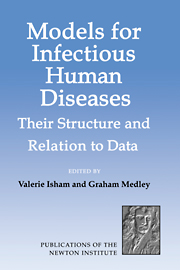Book contents
- Frontmatter
- Contents
- Introduction
- Participants
- Non-Participant Contributors
- Part 1 Transmissible diseases with long development times and vaccination strategies
- Part 2 Dynamics of immunity (development of disease within individuals)
- Evolutionary dynamics of HIV infections
- Statistical models for analysis of longitudinal, CD4 data
- Some mathematical and statistical issues in assessing the evidence for acquired immunity to schistosomiasis
- Virulence and transmissibility in P. falciparum malaria
- Invited Discussion
- Invited Discussion
- Invited Discussion
- Lifespan of human T lymphocytes
- Diversity and virulence thresholds in AIDS
- Statistical analysis of AZT effect on CD4 cell counts in HIV disease
- Modeling progression of HIV infection: staging and the Chicago MACS cohort
- The interpretation of immunoepidemiological data for helminth infections
- The distribution of malaria parasites in the mosquito vector: consequences for assessing infection intensity in the field
- When susceptible and infective human hosts are not equally attractive to mosquitoes: a generalisation of the Ross malaria model
- The dynamics of blood stage malaria: modelling strain specific and strain transcending immunity
- Part 3 Population heterogeneity (mixing)
- Part 4 Consequences of treatment interventions
- Part 5 Prediction
Invited Discussion
Published online by Cambridge University Press: 04 August 2010
- Frontmatter
- Contents
- Introduction
- Participants
- Non-Participant Contributors
- Part 1 Transmissible diseases with long development times and vaccination strategies
- Part 2 Dynamics of immunity (development of disease within individuals)
- Evolutionary dynamics of HIV infections
- Statistical models for analysis of longitudinal, CD4 data
- Some mathematical and statistical issues in assessing the evidence for acquired immunity to schistosomiasis
- Virulence and transmissibility in P. falciparum malaria
- Invited Discussion
- Invited Discussion
- Invited Discussion
- Lifespan of human T lymphocytes
- Diversity and virulence thresholds in AIDS
- Statistical analysis of AZT effect on CD4 cell counts in HIV disease
- Modeling progression of HIV infection: staging and the Chicago MACS cohort
- The interpretation of immunoepidemiological data for helminth infections
- The distribution of malaria parasites in the mosquito vector: consequences for assessing infection intensity in the field
- When susceptible and infective human hosts are not equally attractive to mosquitoes: a generalisation of the Ross malaria model
- The dynamics of blood stage malaria: modelling strain specific and strain transcending immunity
- Part 3 Population heterogeneity (mixing)
- Part 4 Consequences of treatment interventions
- Part 5 Prediction
Summary
What's so special about within-host dynamics?
When an epidemiology conference hosts a session on ‘within-host dynamics’, three questions immediately come to a discussant's mind: ‘Why are we doing this?’, ‘What are we doing here?’ and ‘What difference does being within a host make?’ The first of these three questions is answered by the quality of the papers presented in this session. There are many fascinating questions about the pathogenesis of infectious diseases, and about the dynamics of host responses to infectious organisms. These questions often involve highly nonlinear interactions between host and pathogen within the host organism. The rigour and clarity of thought required by mathematical description of such interactions is a great aid in developing an intuitive understanding of which processes are important, and of what patterns those processes might generate.
The subject matter of the four talks: two on HIV, one on malaria and one on schistosomiasis is probably a fair representation of the field. The enigma of HIV's pathogenesis has prompted many theoretical (and empirical) investigations. Nowak's theory is one elegant example of the numerous theories proposed to explain the long period between infection with HIV and illness with AIDS (reviewed in McLean 1993). In contrast to the care and rigour with which Nowak's theory has been expounded, some of the ‘verbal theories’ of HIV's pathogenesis are classic examples of why biologists ought to make mathematical models; so that they can see when the predictions made by their verbal models simply cannot be matched up with the patterns they aim to explain. A cogent argument for the use of mathematical models in an exploratory fashion by biologists is given by Hillis (1993).
- Type
- Chapter
- Information
- Models for Infectious Human DiseasesTheir Structure and Relation to Data, pp. 181 - 183Publisher: Cambridge University PressPrint publication year: 1996

